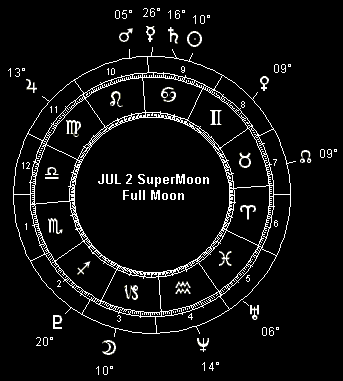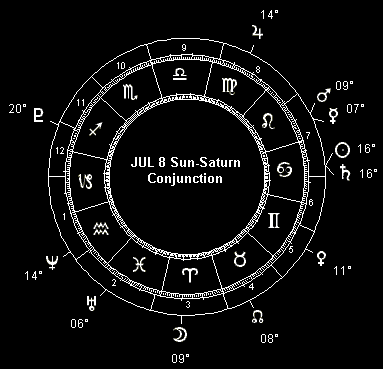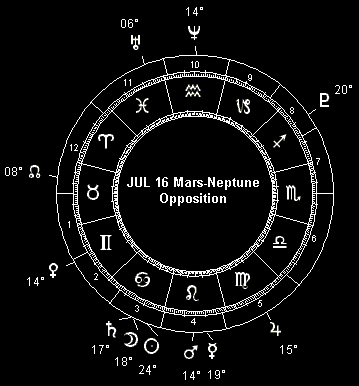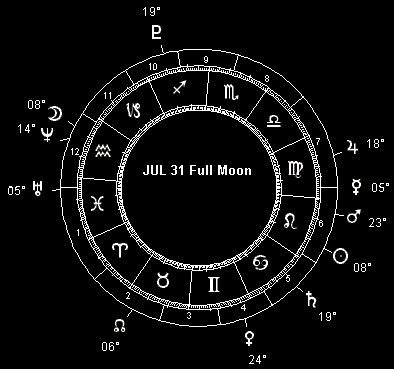If you were expecting some kind of sun sign nonsense, forget it. This is real astrology. See the section above. And if you need help deciphering the astrological glyphs in the graphics accompanying this article, see Astroglyphs: Astrological Symbols Guide. Please note: this forecast is expressed in terms of Universal Time (UT).
The future will be better tomorrow.
-- Dan Quayle
 As promised, June ushered in a bumper crop of severe storms, powerful earthquakes, devastating floods and awesome volcanic eruptions. That's just what to expect when there's a SuperMoon alignment - a new or full moon (syzygy) that occurs when the Moon is at or near its closest approach to Earth (perigee) - as there was in June. As there is in July too, so you can expect more of the same this month as well. Opening up with a full moon SuperMoon and ending with another full moon, July is so stirred up with geocosmic energy that there's hardly more than a few days of relative calm the whole month long. Venus remains very significant this month too, though nowhere near the level of prominence of its first-in-122-years transit of the Sun on June 8. So we can look for continued good news on the economic and financial front, by and large, as I said to expect under the current Venus intersolar phase: "The trend is up . . . but it's a fragile trend." Next among the major themes this month is the Red Planet's opposition to Neptune on the 16th, which makes mid-July look . . . well, threatening. And last but not least is the start of Mercury's intersolar phase as the little planet reaches maximum elongation on the 27th, ushering in six weeks of off and on crossed wires, waylaid messages and infrastructure overloads. Get ready in advance; get ahead now if you can!
As promised, June ushered in a bumper crop of severe storms, powerful earthquakes, devastating floods and awesome volcanic eruptions. That's just what to expect when there's a SuperMoon alignment - a new or full moon (syzygy) that occurs when the Moon is at or near its closest approach to Earth (perigee) - as there was in June. As there is in July too, so you can expect more of the same this month as well. Opening up with a full moon SuperMoon and ending with another full moon, July is so stirred up with geocosmic energy that there's hardly more than a few days of relative calm the whole month long. Venus remains very significant this month too, though nowhere near the level of prominence of its first-in-122-years transit of the Sun on June 8. So we can look for continued good news on the economic and financial front, by and large, as I said to expect under the current Venus intersolar phase: "The trend is up . . . but it's a fragile trend." Next among the major themes this month is the Red Planet's opposition to Neptune on the 16th, which makes mid-July look . . . well, threatening. And last but not least is the start of Mercury's intersolar phase as the little planet reaches maximum elongation on the 27th, ushering in six weeks of off and on crossed wires, waylaid messages and infrastructure overloads. Get ready in advance; get ahead now if you can!
The late June increase in powerful storms and seismicity was just the lead-in to the July 2 SuperMoon full moon at 11 Capricorn. This is another of the year's most potent SuperMoon alignments, occurring on the same day the Moon reaches maximum declination south of the equator, and just over twelve hours after the July 1 lunar perigee (which is the Moon's second-closest approach to Earth all year). With all this going on, you can figure that July 1-5 will have more than its share of dangerous storms with high winds and heavy precipitation. The latter will of course produce instances of destructive flooding and mudslides, but there will be higher than normal coastal tides as well. July 1-5 is also a period of heightened seismic risk, from Richter 5+ quakes to volcanic eruptions. Mudslides and other forms of flooding - including coastal floods due to storm driven high tides - look like a specialty of this SuperMoon. Homes, farms, ranches and mining operations appear to be particularly vulnerable this time around. And, as with last month's SuperMoon, insurance companies will be hard hit by this one.
 With all this storm and seismic potential in mind, you can figure it's a good idea to have your emergency kit current just in case; also to allow for possible weather-related delays if you're traveling or otherwise vulnerable to the elements during the July 1-5 risk window. While earthquakes and volcanic eruptions are pretty much limited to known locales - be on the alert if you plan to be in one during this period - there's practically no place on Earth beyond the reach of nasty weather. So don't think that this SuperMoon can't possibly intrude into your life. That said, astro-locality analysis puts Alaska, the Yukon and British Columbia in the crosshairs, along with Central America and the Pacific coast of South America plus Argentina. (The US heartland and the entire Gulf of Mexico also appear vulnerable to powerful storms at this time.) Across the Atlantic, there's a north-south danger zone bounded by Rome in the west and Stockholm in the east, running out through the southeast tip of Africa. The other major risk zone lies within a northeasterly arc stretching from Indonesia and the west coast of Australia, through Singapore and the southeastern tip of Indochina, along the Chinese coast, through Vladivostok and bracketing Japan on either side.
With all this storm and seismic potential in mind, you can figure it's a good idea to have your emergency kit current just in case; also to allow for possible weather-related delays if you're traveling or otherwise vulnerable to the elements during the July 1-5 risk window. While earthquakes and volcanic eruptions are pretty much limited to known locales - be on the alert if you plan to be in one during this period - there's practically no place on Earth beyond the reach of nasty weather. So don't think that this SuperMoon can't possibly intrude into your life. That said, astro-locality analysis puts Alaska, the Yukon and British Columbia in the crosshairs, along with Central America and the Pacific coast of South America plus Argentina. (The US heartland and the entire Gulf of Mexico also appear vulnerable to powerful storms at this time.) Across the Atlantic, there's a north-south danger zone bounded by Rome in the west and Stockholm in the east, running out through the southeast tip of Africa. The other major risk zone lies within a northeasterly arc stretching from Indonesia and the west coast of Australia, through Singapore and the southeastern tip of Indochina, along the Chinese coast, through Vladivostok and bracketing Japan on either side.
 Venus' long sojourn in Gemini, which began back in April, continues throughout July. Remaining within a few degrees of its 10 Gemini June 29 direct station until mid-month, Venus stays intersolar (on the same side of the Sun as Earth) all through July and into August (finally reaching maximum western elongation and passing behind the plane of the Sun on the 17th of that month). This means more of the welcome economic growth trends that have been in evidence ever since the end of March, when this year's Venus intersolar cycle began. By the same token, love and sex as well as money continue to be a focus of world attention this month; along with a growing but still fragile trend toward peace and reconciliation among and within nations. Since last month's Venus transit across the Sun, the US in particular has benefited from a number of foreign relations developments that have been surprisingly positive. These included an unprecedented unanimous UN Security Council vote supporting the US peace and reconstruction plan for Iraq, on the very day Venus crossed the solar disk. This was followed in a few weeks by the transfer of sovereignty in Iraq. And the month as a whole was graced with a number of upbeat economic and financial indicators, including healthy advances in all the major market indices. ("Having the 2004 Venus solar transit conjunct Mars in the seventh house of the national horoscope is a most auspicious and favorable indicator for the USA," I wrote last year, "suggesting successful military campaigns, better relations with allies, and improvement in the nation's economy and financial system.")
Venus' long sojourn in Gemini, which began back in April, continues throughout July. Remaining within a few degrees of its 10 Gemini June 29 direct station until mid-month, Venus stays intersolar (on the same side of the Sun as Earth) all through July and into August (finally reaching maximum western elongation and passing behind the plane of the Sun on the 17th of that month). This means more of the welcome economic growth trends that have been in evidence ever since the end of March, when this year's Venus intersolar cycle began. By the same token, love and sex as well as money continue to be a focus of world attention this month; along with a growing but still fragile trend toward peace and reconciliation among and within nations. Since last month's Venus transit across the Sun, the US in particular has benefited from a number of foreign relations developments that have been surprisingly positive. These included an unprecedented unanimous UN Security Council vote supporting the US peace and reconstruction plan for Iraq, on the very day Venus crossed the solar disk. This was followed in a few weeks by the transfer of sovereignty in Iraq. And the month as a whole was graced with a number of upbeat economic and financial indicators, including healthy advances in all the major market indices. ("Having the 2004 Venus solar transit conjunct Mars in the seventh house of the national horoscope is a most auspicious and favorable indicator for the USA," I wrote last year, "suggesting successful military campaigns, better relations with allies, and improvement in the nation's economy and financial system.")
The over-all picture for July shapes up as similar in these respects. But there are counter-trends at work here and there as well, most particularly around the 8th (when the Sun aligns with Saturn); plus the 20th and 25th (give or take a few days in either case), when Venus squares Jupiter and Pluto respectively). And ultimately, as I've already noted, any economic upturn associated with the Venus intersolar cycle is "fragile rather than robust - the kind of thing that could run for months or even a year or so, but not a whole lot longer." So as the poet said, "Gather ye rosebuds while ye may," and as the astrologer forewarned you last year in this connection, "Don't mistake a temporary boomlet for more than what it is."
 After the SuperMoon geocosmic turbulence fades out on the 5th, the next really notable peak in storm and seismic potential will be in effect July 14-20, in association with Luna's northern declination extreme on the 15th and the new moon at 25 Cancer on the 17th. (There will be a brief upsurge a day either side of the lunar equatorial crossing on the 8th: croplands, lakes and rivers are likely target zones.) From moderate to severe seismic activity (Richter 5+ quakes and volcanic eruptions) to destructive storms with strong winds and heavy precipitation, July 14-20 is a period of special vulnerability to natural disaster. It's a good time to have your emergency gear ready and replenished. Lightning and windstorms appear to be a specialty of this lunar phase, so keep a good weather eye on the sky. And if you live in an earthquake-prone locale, it wouldn't hurt to lay the good china down someplace safe - just in case. Remembering that all of Planet Earth is vulnerable at times like this, it nonetheless appears that Japan and eastern China, Central Europe, the Middle East and East Africa, the US Great Plains and Northeastern states plus Alaska and Hawaii are among the more likely target zones during the few days either side of the July 17 new moon.
After the SuperMoon geocosmic turbulence fades out on the 5th, the next really notable peak in storm and seismic potential will be in effect July 14-20, in association with Luna's northern declination extreme on the 15th and the new moon at 25 Cancer on the 17th. (There will be a brief upsurge a day either side of the lunar equatorial crossing on the 8th: croplands, lakes and rivers are likely target zones.) From moderate to severe seismic activity (Richter 5+ quakes and volcanic eruptions) to destructive storms with strong winds and heavy precipitation, July 14-20 is a period of special vulnerability to natural disaster. It's a good time to have your emergency gear ready and replenished. Lightning and windstorms appear to be a specialty of this lunar phase, so keep a good weather eye on the sky. And if you live in an earthquake-prone locale, it wouldn't hurt to lay the good china down someplace safe - just in case. Remembering that all of Planet Earth is vulnerable at times like this, it nonetheless appears that Japan and eastern China, Central Europe, the Middle East and East Africa, the US Great Plains and Northeastern states plus Alaska and Hawaii are among the more likely target zones during the few days either side of the July 17 new moon.
Mars opposes Neptune on the 16th, although these two are within a few degrees of their exact alignment from the 11th through the 25th. This is likely to be an interval rife with terror attacks - certainly suicide bombers and other familiar murderous atrocities, perhaps utilizing chemical or biological weapons as well. Accidents involving hazardous substances are likely to make headlines during this period. Not a good time to live next to a chemical plant, I should think. Funny, how many of the same people who think it just makes good sense to have a fire extinguisher handy, look upon gas masks as being over the top. Anyone who lives within a mile of a chemical plant or depot, a major highway or a railway, really ought to think that one through again.
 Except for a day either way of the 23rd, I don't see another notable geocosmic stress build-up until the 28th, as we come into the Moon's south declination maximum and lunar perigee leading into the full moon on the 31st: that's the dramatic grand finale in a month that will be remembered for destructive storms, floods, earthquakes - and probably volcanic eruptions, too. Be ready for this one, it's very nearly as potent as the SuperMoon effect at the beginning of July. Destructive storms are apt to wreak havoc on power, transportation and communication infrastructure as July draws to a close, under a heap of geophysical stress and Mercury reaching maximum elongation east of the Sun. (I'm thinking primarily of storms in the meteorological sense, but solar and geomagnetic storms can play a part in the picture I see toward the end of July.) By now you should know the drill: candles, flashlights and fresh batteries, bottled water and a few canned goods can be mighty handy in the pantry if you're one of the many who'll get cut off from the world for a while. And if you're traveling, be sure to allow extra time for weather-related delays. While no place is beyond the reach of Mother Nature on a rampage, it does appear that the Mississippi River Valley, the Gulf of Mexico and southern Mexico/Central America are in the crosshairs this time around, along with Cuba, Hispaniola, the US Atlantic coast and the Pacific coast of South America; also Eastern Europe (to Moscow), Turkey and from central China down through the Indochina peninsula.
Except for a day either way of the 23rd, I don't see another notable geocosmic stress build-up until the 28th, as we come into the Moon's south declination maximum and lunar perigee leading into the full moon on the 31st: that's the dramatic grand finale in a month that will be remembered for destructive storms, floods, earthquakes - and probably volcanic eruptions, too. Be ready for this one, it's very nearly as potent as the SuperMoon effect at the beginning of July. Destructive storms are apt to wreak havoc on power, transportation and communication infrastructure as July draws to a close, under a heap of geophysical stress and Mercury reaching maximum elongation east of the Sun. (I'm thinking primarily of storms in the meteorological sense, but solar and geomagnetic storms can play a part in the picture I see toward the end of July.) By now you should know the drill: candles, flashlights and fresh batteries, bottled water and a few canned goods can be mighty handy in the pantry if you're one of the many who'll get cut off from the world for a while. And if you're traveling, be sure to allow extra time for weather-related delays. While no place is beyond the reach of Mother Nature on a rampage, it does appear that the Mississippi River Valley, the Gulf of Mexico and southern Mexico/Central America are in the crosshairs this time around, along with Cuba, Hispaniola, the US Atlantic coast and the Pacific coast of South America; also Eastern Europe (to Moscow), Turkey and from central China down through the Indochina peninsula.
Finally, remember that July closes as Mercury's intersolar phase begins, when the little planet reaches maximum elongation on the 27th. Central to this phase, which lasts until September 9 (and which includes the infamous Mercury retrograde), is a sharp focus on all that has to do with transportation, planning, commerce and communication. The whole infrastructure supporting these processes tends to be about a hair's breadth from breakdown at times like this - and all it takes is one human error, one additional stress or overload to bring it all to a collapse. Trust nothing to chance, double-check it all and make sure you've got backup copies of anything important. Assume nothing, except that Murphy's Law is the cardinal principle while Mercury is intersolar. This would be a good time to edit, review, correct and fix - if only because there's plenty of grist for the mill. It's also a good time for a check-up on your credit report and your personal security protocols (electronic as well as physical): hackers, crackers, thieves and other clever fiends are burning the midnight oil now, so honest people cannot rest easy as July turns into August.
 SPECIAL FEATURE: This month's birthdays of the famous and infamous (with astrological birth charts)
SPECIAL FEATURE: This month's birthdays of the famous and infamous (with astrological birth charts)
